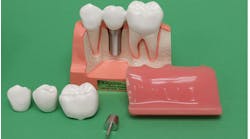We all walk in the dark and each of us must learn to turn on his or her own light. ~ Earl Nightingale
2022 was a dark year for investing; most asset classes suffered significant losses. The S&P 500 was down almost 20%, and the NASDAQ was over 30% lower. For those investing in cryptocurrencies, bitcoin was down more than 80%.1 Market losses such as these will take a toll on dentists’ investment portfolios, especially their retirement savings. This type of loss in the stock market can take five years at a 6% rate of return to make back your original investment. But an “investment light” can help recover investment losses sooner.
A critical element in investing is the sequence of returns. Most advisors discuss average rates of return when investing, which have minimal to no importance for a dentist’s long-term wealth-building. Those who have gotten a later start on investing due to education and student loan debt, for example, may find it difficult to overcome events such as the dot com crash, the 2008 financial meltdown, and today’s uncertain economics. Market fluctuations have a big impact on investors’ financial well-being.
You may also be interested in ...
What is the metaverse—and how is dentistry affected by it?
The industrial revolution of money: Investing in bitcoin and cryptocurrencies
Since most dentists invest in the stock market either inside or outside their retirement plan, they are exposed to these market fluctuations, which can result in delaying retirement for many years. These issues can be mitigated by diversifying the financial portfolio and utilizing alternative investments. One purpose of alternative investments is to enhance the rate of return while maintaining a similar risk level. The type of investment that can do this in a stock portfolio may surprise you: it’s bitcoin, which is a cryptocurrency.
What are cryptocurrencies?
Cryptocurrencies have been a hot topic in the media in the last year with multiple bankruptcies of crypto companies such as BlockFi and Celsius, among others, and the implosion of FTX and its previous owner, Sam Bankman-Fried. While this has put a black stain on the industry, it doesn’t mean that the underlying technology, the blockchain, is going away anytime soon.
The blockchain is a digital ledger that stores data in a decentralized manner so that it’s an immutable, peer-to-peer network. Cryptocurrencies are built on the blockchain, and bitcoin is the first and largest cryptocurrency by market capitalization among 22,000-plus cryptocurrencies.2 Bitcoin is a cashless payment system that doesn’t require a third party. It was created by Satoshi Nakamoto (anonymous developers) in 2009. Since its inception, it has been considered the best performing asset class with an annualized rate of return of 230% from 2011 to 2021, with significant losses over two of those years.3
Bitcoin returns have been substantial. Years ago, bitcoin moved in an opposite direction to equities. This asymmetry has lessened in recent years due to greater adoption by institutional investors, but it hasn’t reduced the volatility evident in 2022. But that volatility can be used to one’s advantage as an alternative investment.
How can bitcoin help your financial portfolio?
Bitwise Asset Management did a research report in May 2020 to determine if adding bitcoin to a portfolio benefited it in any way.4 Results were stunning. The five-year study compared a traditional 60% stock/40% bond portfolio to the same portfolio plus 2.5% bitcoin. Adding bitcoin, the portfolio’s rate of return doubled from 24% to almost 45% with quarterly rebalancing.
But as incredible as this is, it gets even better because the standard deviation or volatility was essentially the same (10.34% without bitcoin and 10.07% with bitcoin). This means that the dentist’s rate of return can potentially be much better with bitcoin at the same risk. Dentists may be hurting themselves financially by not incorporating bitcoin into their investment strategies. (Note: this is not investment advice. Please consult your financial professional for further information.)
How cryptocurrencies work
Only about 300 million people own cryptocurrencies,5 a small percentage of the world’s population, so there’s a lot of room for growth. Adoption of bitcoin and cryptocurrencies is expanding, and with this growth it’s becoming easier to invest in this asset class. Coinbase is a common exchange for investors to onboard cryptocurrency by connecting it to their bank account,6 but there are nuances you need to know about regarding storing these assets once you invest in them.
Storage options from most to least secure include what is called a cold wallet (like a USB stick such as a Ledger or Trezor that disconnects from the computer),
a hot wallet (a file on your computer or phone such as Exodus.io), or a centralized exchange (on your computer or phone such as Coinbase). Investors who don’t want to deal with these kinds of storage and custody can invest directly in a cryptocurrency fund, like an Ameritrade account, but one typically must be an accredited investor to do so.
If dentists add cryptocurrency to their portfolios as an alternative investment, deciding how the assets are to be custodied is very important. There is a common term in crypto, “Not your keys, not your crypto,” that gets to the heart of where the cryptocurrency is stored and who has access to it. Based on what we see from clients, the overwhelming percentage of dentists’ assets (beside their practices) reside in their retirement plans. The investments are usually stocks and bonds in some form of a structured portfolio like a 60:40. The annualized rate of return for the S&P 500 since 1971 has been 10.71% with dividends reinvested.7 However, when considering current inflation, taxes, and fees, the rate of return erodes significantly.
In these challenging economic times, adding a small percentage of bitcoin to your portfolio has been shown to improve performance. (Note: past performance is no guarantee of future results.) Having more assets at retirement means more income and enjoyment in the golden years. Bitcoin could become the light we need for investments in the future.
Editor's note: This article appeared in the March 2023 print edition of Dental Economics magazine. Dentists in North America are eligible for a complimentary print subscription. Sign up here.
References
- Rose J. Bitcoin historical annual returns (10 years, 5 years, 3 years, 1 year). Good Financial Cents. January 1, 2023. https://www.goodfinancialcents.com
- CoinMarketCap. https://coinmarketcap.com/
- Drake A. Global Crypto. Arrel Technology. March 16, 2021. https://www.arreltech.com
- Lawant D, Hougan M. The case for crypto in an institutional portfolio. Bitwise Investments. May 2020. https://static.bitwiseinvestments.com/Research/Bitwise-The-Case-For-Crypto-In-An-Institutional-Portfolio.pdf
- McGovern T. Cryptocurrency statistics 2023: How many people use crypto? EarthWeb. Updated December 3, 2022. https://earthweb.com/cryptocurrency-statistics/
- What does Coinbase do with my digital assets? Coinbase. https://help.coinbase.com/en/coinbase/other-topics/legal-policies/what-does-coinbase-do-with-my-digital-assets
- Sullivan B, Curry B. Average stock market return. Forbes Advisor. August 17, 2022. https://www.forbes.com/advisor/investing/average-stock-market-return/






